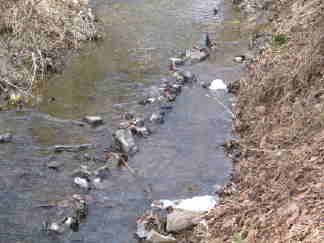![]() Observation: The First Step in the Scientific Method
Observation: The First Step in the Scientific Method
Observations are also called data. There are two kinds of data.
- Qualitative data which are descriptions that do not have numbers.
The farmer noticed that the leaves of much of his lettuce crop were turning brown and shriveling., is an example of qualitative data.
- Quantitative data are obtained by making measurements and have numbers.
Scientists use instruments (tools) to obtain numbers based data.The driest month in Miami, Florida is January with 1.88 inches of precipitation. There is 66% Sunshine hours. With 8.63 inches of precipitation, August is the wettest month. Still Miami's August has 71% Sunshine hours. - is an example of quantitative data.
It is important to be a careful observer. Small details can be the important clues that lead the investigator to the answer to a question.
Jay was walking along a country road when he saw this stuff in the creek.
Click here for a closer view. Use the Back Button of your browser to return to this web page.
1. Write your observations
2. Imagine - If you were standing in the scene:
What tools (instruments) would help you to gather critical data?
3. Take a guess (form a hypothesis) - What happened here?
Scientists seek to answer questions. They make observations as the first step to the scientific method.
4. Based on your observations, would you advise consuming any water from the creek?
“If there is magic on this planet, it is contained in water." Loran Eisely, The Immense Journey, 1957
Explore further:
About Units of Measurement - IB Biology | Observing Biology how to's
Monitoring and Assessing Water Quality | The Water Cycle | Common Measuring Water - USGS
Steps of the Scientific Method - Science Buddies | Learn about the Scientific Method
Observation Science Skills Builders | The Scientific Process
Bluebirds Project | Fields, Meadows and Fencerows EcoStudy Unit

All trademarks, copyright and logos belong to their respective owners.
Internet Hunts / Nature / Computers / Pennsylvania Projects / Water and Watersheds unit / Puzzles & Projects / Site map / Mrs O's House Cynthia J. O'Hora Posted 3/2009 released to free use in a nonprofit setting.
Aligned with Pennsylvania Academic Standards | Assessment and Rubrics
Save a tree - use a Digital Answer Format - Highlight the text. Copy it. Paste it in a word processing document. Save the document in your folder. Answer on the word processing document in an easily read, contrasting color (Not yellow ) or font. Avoid fancy fonts like: Symbols, Techno,
fonts). Save frequently as you work. I have never liked losing my work. You will not like it either. Be sure to enter your name & the date at the top of the document, in a header. Submit the assignment via email attachment or electronic class dropbox. Bad things happen: Save a copy of the response document for your records.
Proof your responses. It is funny how speling errors and typeos sneak in to the bets work.
Make your own printer paper answer sheet
